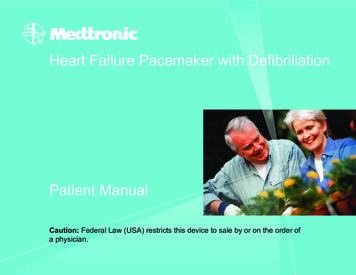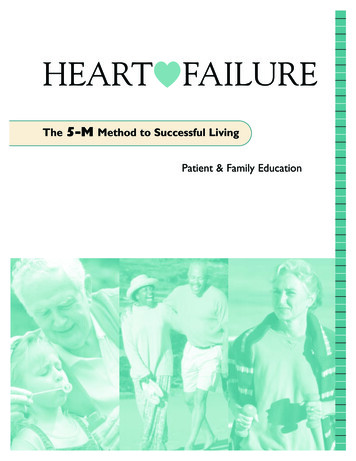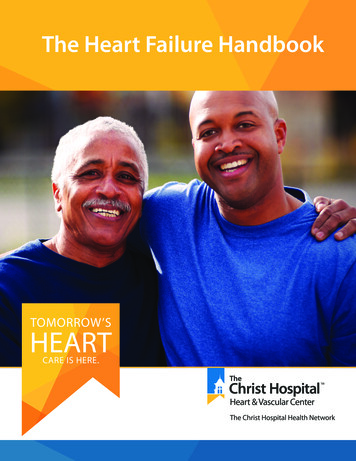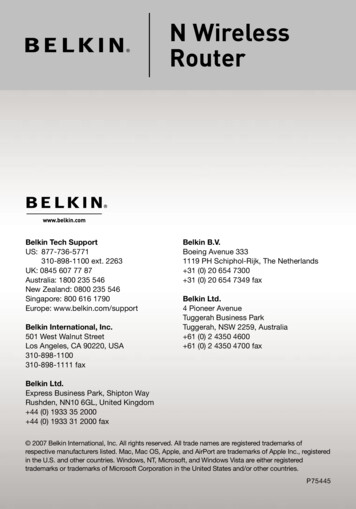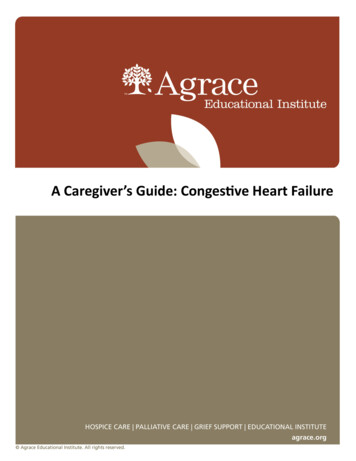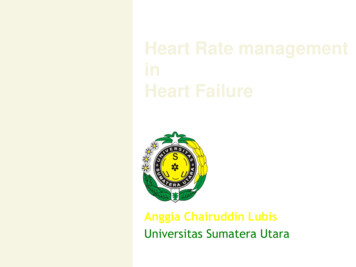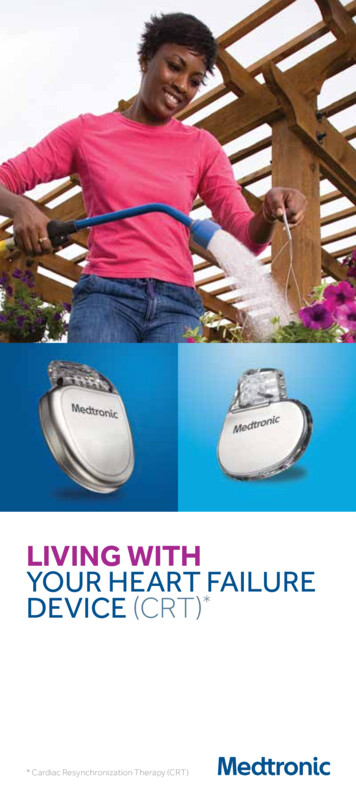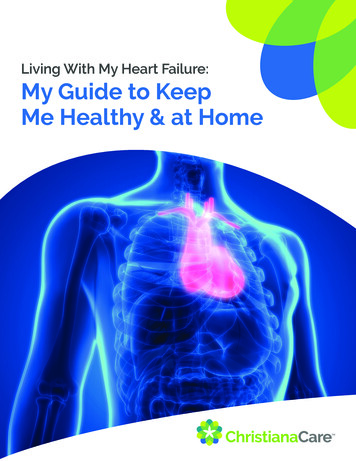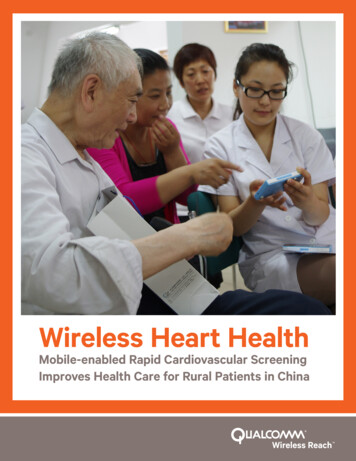
Transcription
Wireless Heart HealthMobile-enabled Rapid Cardiovascular ScreeningImproves Health Care for Rural Patients in China
CONTENTSExecutive Summary.5Case Description.6Cardiovascular disease: A rising health burden that increasingly affects rural residents.6Wireless Heart Health: Using mobile broadband to assist underserved patients with CVD.7Case in point: Wireless Heart Health program succeeds in Shandong.8Methodology and execution: Capitalizing on collaborative resources. 11Research Findings.12Respondents are rural providers at private and public clinics.13Smartphone-based ECG testing is improving access to CVD care.13Smartphone-based CVD screening is affordable and sustainable.14ECG-sensing smartphone is more or equally reliable as 12-lead ECG machine.15Life Care Networks’ Call Center improves rural providers’ care for CVD patients.15ECG-sensing smartphone improves data management and serves multiple functions.16Opportunities for increasing patient education and advancing technology further.16Robustness Checks.18Respondents are more frequent and better users of the devices than other providers.18Respondents’ patients are not systemically different than those of other providers.19Conclusions. 20Acknowledgements and Program Stakeholders. 203
4
EXECUTIVE SUMMARYExperts agree that the global health burden ofcardiovascular disease (CVD) is on the rise anddisproportionately affects rural residents. Researchersfrom the Shanghai Institute of Cardiovascular Diseaserecently concluded that “the morbidity and mortality ofCVD in China are increasing persistently, although thegovernment has taken an active part in the prevention andcontrol of CVD.”1 Fortunately, experts also agree that earlydetection and consistent monitoring, accompanied bynecessary treatment, have the potential to decrease healthrisks associated with CVD.To support the prevention and management of CVDsin China’s rural communities, Qualcomm WirelessReach launched the Wireless Heart Health program incollaboration with Life Care Networks and the CommunityHealth Association of China in 2011. Wireless Heart Healthtargets providers in rural areas staffing both public andprivate clinics and features a one-lead electrocardiogram(ECG)-sensing smartphone, powered by Qualcomm’sSnapdragon S1 processor, with an electronic health record(EHR) application suite developed by Life Care Networks.Additionally, Life Care Networks provides mobilebroadband-enabled services for remote consultation,diagnosis, and treatment through its call center, staffedaround the clock by cardiac specialists in Beijing.In the fall of 2015, Qualcomm Wireless Reach, Life CareNetworks, and a team of experts from Vital Wave, Inc.designed and implemented a use and satisfaction surveyfor the Wireless Heart Health program. The goal of thesurvey was to understand experiences among health careproviders using the ECG-sensing smartphones to care fortheir patients.The survey showed that participating health careproviders in rural China are very satisfied with the ECGsensing smartphones and believe they are providingimproved care and services to patients with CVD.Key points from the research findings include: Two-thirds (66%) of providers were able to examinemore patients than before by using the ECG-sensingsmartphone, and 61% report making more CVDdiagnoses using the device. Almost one-quarter (23%) of providers offered in-homeECG screenings to patients using the ECG-sensingsmartphone. More than one-half of providers (62%) reportedthat the Life Care Networks Call Center increasedthe accuracy of their diagnoses and that call centerfeedback improved their confidence in providingdiagnoses. Three-quarters (75%) of providers reported that thebiggest benefit of the ECG-sensing smartphones isthe long-run decrease in cost of CVD screening anddiagnosis. ECG-sensing smartphones with the Life Care Networksplatform are six times less expensive for patients thanconventional 12-lead ECG machines: 4.47 RMB versus26.48 RMB.In conclusion, research findings demonstrate that theWireless Heart Health program has been very successfulin supporting rural residents, providers, and governmentagencies addressing the rising health burden of CVD.Simply put, with the ECG-sensing smartphones, costsare decreasing significantly, quality and reach of care isincreasing, and satisfaction is high among patients andpractitioners.EXECUTIVE SUMMARY5
CASE DESCRIPTIONCardiovascular disease: A rising health burden thatincreasingly affects rural residentsAccording to the World Health Organization, noncommunicable diseases (NCDs) — including CVD — haveplaced a grave economic burden on countries.2 In fact,China will lose 27.8 trillion USD in national incomebetween 2012 and 2030 –amounting to over 1.5 trilliona year—due to the five main NCDs (CVD, cancer, chronicrespiratory disease, diabetes, and mental health). CVDwas one of two NCDs in the lead for most costly.3 CVDssuch as coronary heart disease, heart failure, andarrhythmia are the leading cause of death in China,responsible for approximately 2.6 million deaths annually.By 2020, deaths caused by CVD are projected to increaseto 4 million per year.4Researchers from the Shanghai Institute of CardiovascularDisease recently concluded that “[d]espite revolutionaryadvancement in medicine over the past century, CVDremains the leading cause of death and disability inthe world. Likewise, the morbidity and mortality ofCVD in China are increasing persistently, although thegovernment has taken an active part in the prevention andcontrol of CVD.”5 Luo Zhengxiang, head of the GuangdongCardiovascular Disease Research Institute6 notes, “CVDhas spread to many rural areas in most parts of China,where medical care is less adequate than what can befound in the cities.”76CASE DESCRIPTIONA recent 800-person study published by the NationalHeart, Lung, and Blood Institute8 found that smartphonesequipped with ECG sensors could accurately detect themost common heart arrhythmia, atrial fibrillation (AF). AFcan increase the risk of stroke and, in some, chest painand heart failure.9 Study participants noted that using asmartphone to monitor their heart significantly increasedawareness of their heart rate and behavior. In a largestudy in China with over 450,000 individuals, researchersconcluded that “[t]he lifetime risk of AF was approximatelyone in five among Chinese adults, and it increased withadvancing age.” Further, “[t]he AF burden, as well asthe risk of AF-related stroke, has increased significantlyover the past 11 years in the southwest of China.”10 Thepotential burden and implications for health care systemsare major given the common occurrence of this heartarrhythmia.Experts from around the world agree that CVDs are on therise and early detection and consistent monitoring throughECG screening, paired with necessary treatment, have thepotential to decrease health risks associated with CVD.
Wireless Heart Health: Using mobile broadband to assistunderserved patients with CVDIn China, there are more than 1.3 billion mobile phone users– one for every person in the country.11 As of late 2015,more than 620 million people in China were accessingthe Internet via mobile phones, accounting for 90% ofthe country’s Internet-using population.12 Advancedwireless technology is not only creating businessopportunities across a variety of industries, but is alsooffering incredible opportunities to solve social challengesand improve people’s lives. To support the preventionand management of CVDs in rural communities in China,Qualcomm Wireless Reach launched the Wireless HeartHealth program in collaboration with Life Care Networksand the Community Health Association of China. ChinaTelecom helped them enter the public health arena andhelped them engage local health bureaus and sell thedevice for public health data collection and other related work.The Wireless Heart Health program features a mobilebroadband-enabled system developed by Life CareNetworks. This system includes a smartphone with threebuilt-in ECG sensors comprising one-lead (or one angleof measuring the electrical activity of the heart), and anEHR platform that offers instant access to patient records,including ECG data. Providers hold the device to patients’chests for approximately 30 seconds while the ECGsensor collects their ECG data. The data is automaticallystored in the patient’s EHR and sent immediately over the3G or 4G LTE wireless network for analysis by a cardiacspecialist at the Life Care Networks Call Center, staffedaround the clock in Beijing. The on-call cardiac specialistsprovide prompt feedback within minutes to clinic staff andpatients via SMS or a phone call. Currently, the call centerhas 72 physicians and ten nurses triaging requests andproviding rapid diagnosis around the clock.Qualcomm Wireless Reach is the main funder of theWireless Heart Health program and provides projectmanagement support. In addition to providing ECGsensing smartphones and call center resources, Life CareNetworks also trains many participating clinicians. From2011 to 2013, Community Health Association of Chinaaided in site selection, program implementation, andimpact analysis; from 2014 to present, China Telecom andMomentum have assumed this role. Patient data in theEHR and in the ECG-sensing smartphone is protectedby SSL encryption. Life Care Networks partners closelywith government health systems, so data adheres to thegovernment’s protection and privacy standards in order tointegrate with government hospital-grade EHRs.The Wireless Heart Health program targets rural providersat both public and private clinics. Patients that benefitfrom the program are largely rural, some of whom aremanaging known chronic CVD and some of whom arebeing screened for CVD for the first time. To date, thereare approximately 600 community health centers andclinics actively using the ECG-sensing smartphones toscreen patients and conduct remote consultation withthe Life Care Networks Call Center. More than 160,000patients across 21 provinces and direct-controlledmunicipalities have benefitted from the Wireless HeartHealth program to date.13Given that the need for CVD diagnosis and managementwill be ongoing, the Wireless Heart Health program wasdesigned to be financially sustainable and is not relianton future funding from Qualcomm Wireless Reach. Therural health care providers participating in the WirelessHeart Health program, of which there are over 600,received ECG-sensing smartphones at no cost. Movingforward, providers will continue to receive ECG-sensingsmartphones for free, contingent upon a three-yearcommitment to pay a monthly service fee of 150 RMB ( 24USD) to China Telecom. Market research by Life CareNetworks has shown that each rural doctor will earn about300 RMB ( 48 USD) per month from the delivery of ECGscreenings, which means they will capture roughly 150RMB ( 24 USD) in revenue. Patients will pay an averageprice of 10 RMB ( 1.60 USD) for a screening using theECG-sensing smartphone. The Chinese governmentprovides a 50 RMB ( 8 USD) subsidy toward heath carecosts, which patients can use to pay for ECG screenings.CASE DESCRIPTION7
Case in point: Wireless Heart Health program succeedsin ShandongThe northern coastal province of Shandong is the secondmost populous in China, with over 97 million inhabitants.Similar to other countries across the globe and otherprovinces in China, Shandong faces rising CVD risks. Inresponse to this growing need for CVD screening and care,nearly 450 ECG-sensing smartphones have been deployedin Shandong as part of the Wireless Heart Health program.The following profiles of three clinics in Shandongillustrate the Life Care Networks system in action.Lang Mao Shan Clinic, Shi Zhong District,Jinan CityLang Mao Shan clinic is one of 1,300 private clinicsoutside Jinan city in Shandong province. Due to theimbalanced distribution of medical resources in China,the private clinic is an important supplement to publichospitals, particularly in remote and underdeveloped areas.Established in early 1990s, the clinic currently has two fulltime providers and seven nurses. It serves about 80,000community residents and delivers health services to anaverage of 350 patients per day.Dr. Ren Nianbao and Dr. Xie Guangguo are the two fulltime providers at Lang Mao Shan clinic and have bothworked at the clinic for about 20 years. About 20% of thepatients Dr. Ren and Dr. Xie see each day are sufferingfrom CVDs.In the past, the clinic relied on a conventional 12-leadECG machine to screen for CVDs. The large, complexmachine made it especially difficult to screen patientswith a potential risk of acute CVD who may have neededimmediate help.To help Dr. Ren and Dr. Xie better serve their patients,Qualcomm Wireless Reach, Life Care Networks, andChina Telecom worked together to deploy ECG-sensingsmartphones to conduct quick and accurate heartscreenings, as well as to connect community providers toheart experts at the Life Care Networks Call Center 500kilometers away in Beijing for consultation. It takes twoto eight minutes for the Life Care Networks Call Center8CASE DESCRIPTIONto send back diagnosis and treatment recommendations,depending on the seriousness of the case.In 2015, there were five cases where patients’ screeningresults showed serious myocardial infarction (heartattack) symptoms. Thanks to the innovative heart healthtechnology offered by the ECG-sensing smartphone,patients received timely referral recommendations fortreatment by specialists at hospitals.When asked how using the smartphone has changed hispractice, Dr. Ren stated gravely, “[w]e can’t live withoutthe device and go back to the way things were before.” Hecites increasing demand for ECG services due to youngerand younger patients being at-risk for CVDs – patients intheir forties are now showing signs of CVD risk.With the improved ease and access to ECG screening,patients are beginning to understand the risksbetter and are more willing to comply with treatmentrecommendations. Dr. Xie noted, “[m]any patientsproactively request to be screened with the smartphonenow they trust it more than the old machine!” Allproviders offered high praise for the Life Care NetworksCall Center services and considers the ECG-sensingsmartphone to be more convenient, equally accurate, andmore reliable compared with ECG machines.Community Clinic, Shanghe County,Xin Zhuang VillageXin Zhuang village community clinic is one of about 500public community clinics in Shanghe county. Establishedin 2005, it is one of 20 community clinics in the countythat have benefitted from Qualcomm Wireless Reach’ssupport as part of the Wireless Heart Health program.The community clinic currently has two full-time providersand four nurses. For 15 years, Dr. Li Zhongcheng andDr. Kang Chunli, a married couple, have led the clinic inserving about 1,110 residents of two nearby villages. Theaverage patient load is 70-80 per day. The ECG-sensing
smartphone is used to screen 10-15 CVD patients on adaily basis, about 20% of the total patients seen. Theproviders love the functionality of the device and thebuilt-in EHR records and will frequently refer to previousECG readings and diagnosis stored in the system when rescreening patients at their regularly scheduled check-up.or validate their own diagnoses, but patients also trust thediagnoses and follow through with their treatments moreIn addition to the screening and record-keeping benefitsof the ECG-sensing smartphones, Dr. Li and Dr. Kangare able to transport the device to patients’ homesimmediately, if they call with symptoms of cardiac distress.Dr. Li has made emergency visits to patients’ homes whenthey are experiencing heart pain or other issues to providethem immediate diagnosis and peace of mind. He likesto be able to provide this kind of service. In the winter itis especially convenient because patients don’t have toremove their shirt completely for the screening.The Shang Bo Tou community clinic has been servingpatients for over 30 years. This public clinic currently hasthree full-time health care providers: one attending doctor,one paramedic, and one public health specialist.What Dr. Li and Dr. Kang cite as most helpful is the expertrecommendations from the call center. Because they arenot specialists, the cardiac experts provide diagnosesthat are much more accurate than their own, and theylearn from working closely with the call center doctors.For example, they cited the case of a teenager who hada fast heartbeat and a slightly irregular ECG screening.They thought it might be myocarditis, or inflammation ofthe middle layer of the heart wall, but the LCN call centerrecommended they look into potential emotional issuescausing the irregularities. After talking to the teenagerfurther, Dr. Li and Dr. Kang uncovered that he missed hisparents because they had migrated to another city to workand left him behind with other family members. Insteadof treating him for a very serious heart condition, theyreferred him to a psychologist.Dr. Li and Dr. Kang also appreciate that the Life CareNetwork Call Center not only offers diagnosis andtreatment recommendations, but provides diseaseprevention suggestions such as alimentary control,nutritional supplement and physical exercise. For thisclinic in Xin Zhuang Village, providing patients withunprecedented access to expert opinions right in theirown backyard has transformed their ability to treatpatients with CVD. Not only can local providers improvebecause of the cardiac experts’ recommendations.Shang Bo Tou Community Clinic, Xiawa County,Binzhou CityDr. Zhang Yanzhao, the attending doctor, serves about1,200 residents of one nearby village. The average patientload is 50 to 60 per day. He uses the ECG-sensingsmartphone to screen about 10 to 15 CVD patients ona daily basis, about 20 to 25% of the total patients seen.He has one elderly patient who was diagnosed withcoronary heart disease and at one point had a heartattack. After the heart attack and treatment, the patientcontinued to receive screenings every two weeks tomonitor his condition. The patient complied with histreatment regimen, and Dr. Zhang could see that thepatient’s treatment compliance correlated with improvedECG screenings by tracking his ECG regularly on thesmartphone. The results demonstrated that the treatmentwas working. Before using the ECG-sensing smartphone,Dr. Zhang felt there was much more risk of incorrectlydiagnosing or treating patients. Now, with the assistanceof the Life Care Networks’ call center cardiac specialistsand the smartphone solution, he has confidence in hisability to serve patients.With expert medical advice and electronic ECG recordsat his fingertips, Dr. Zhang is pleased that he can takea more scientific approach to his patients’ health care.These Shandong case studies have demonstrated that LifeCare Networks’ ECG-sensing smartphone is creating seachange in CVD care across China, one mobile connectionat a time.CASE DESCRIPTION9
10CASE DESCRIPTION
Methodology and execution: Capitalizing oncollaborative resourcesIn the fall of 2015, Life Care Networks, Qualcomm WirelessReach, and a team of experts from Vital Wave, Inc.designed and implemented a self-administered use andsatisfaction survey for health care providers participatingin the Wireless Heart Health program. The goal of thesurvey was to better understand the use and satisfactionof Life Care Networks’ ECG-sensing smartphones and callcenter services.The survey was designed to collect self-reported answersto the following key research questions: Does the device improve the health care providerexperience by making ECGs easier to conduct, savingtime, improving data management, and providingexpert diagnosis? Does the device improve the patient experience, asperceived by the health care provider, by reducing waittime for results, screening costs, and time and cost forexpert opinions? Are quality of care and doctor-patient trust improvedby connecting rural providers and patients toexperts via a remote device and a mobile broadbandconnection?The survey instrument was designed collaborativelyby Qualcomm Wireless Reach, Life Care Networks, andVital Wave, Inc. Once the instrument was finalized, LifeCare Networks built a data collection tool on the ECGsensing smartphone platform and pushed the survey outto the population of about 600 participating health careproviders already using the devices.It is important to acknowledge the limitations of thesurvey design and the potential bias these limitationsmay have introduced. First, the survey sample wasnot representative of the entire population of Life CareNetworks’ ECG-sensing smartphone users, because onlythe population participating in the Wireless Heart Healthprogram were asked to complete the survey. Also, due tothe support of China Telecom’s recruitment effort, manyof the responses are concentrated in Heze, Shandong.Similarly, recruitment by Momentum resulted in responsesfrom 21 provinces.In addition, the fact that Life Care Networks wascollecting data about its own products and services mayhave made respondents hesitant to offer any negativeor critical feedback. This is known as social desirabilitybias and is a common phenomenon in survey research.Importantly, participants’ names were not collected, theywere encouraged to give honest feedback, and all wereinformed that their responses would only be analyzedat the aggregate, not individual level, protecting theiranonymity.Despite the limitations caused by these sources ofpotential bias, the research team was able to understandand correct for the bias created by selection into thesurvey by using inverse attrition propensity weighting.This is done by calculating the sample average responsesthat would have been observed if 100% of device usershad responded to the survey.14Survey participation was voluntary. In order to increaseresponse rates, China Telecom and Shan Hai Dan(Momentum), two distribution partners of Life CareNetworks, aided in the recruitment of responses fromhealth care providers. A total of 220 health care providerscompleted the survey.CASE DESCRIPTION11
RESEARCH FINDINGSOverall, the survey showed that rural providers in China are very satisfied with the ECG-sensing smartphones and haveexperienced a great improvement in the care they are able to provide to CVD patients. The device reduces the costof conducting ECGs and simultaneously improves the accuracy of results and treatment recommendations via the LifeCare Networks Call Center. Patient access to ECGs is increased through the ability to conduct in-home screenings usingsmartphones. For clinic-based screenings, providers cite a reduction in patient waiting time and increased efficiency of datamanagement.Findings suggest that from the providers’ perspective, increased patient education about the device could improve acceptanceand satisfaction among patients, and further system enhancements would increase their own satisfaction with the devices.Detailed findings are outlined in the following pages.Photo: Global Health Media Project12RESEARCH FINDINGS
Respondents are rural providers at privateand public clinicsSurvey respondents work at a mixture of public (60%) andprivate (40%) clinics. Most clinics serve small catchmentareas of under 1,000 people, and serve fewer than 100patients per day. Almost half of the respondents areproviders, one-third are community health workers thatconduct home visits, and the remainder are nurses; most(61%) have worked at the clinic fewer than five years.Clinic role of survey respondentsNurseThe majority of respondents report that 1 in 5 patients attheir clinic have issues related to CVD. Around one-third(35%) of providers surveyed report that conventional 12lead ECGs are still used at their clinic.19%Community Health Worker33%Doctor48%Smartphone-based ECG testing is improving accessto CVD careThe ECG-sensing smartphone from Life Care Networksis increasing the volume of ECGs being conducted inrural China. Since 2012, over 525,000 ECG images havebeen sent over the wireless network using ECG-sensingsmartphones, about 160,000 of which were devicescovered by the Wireless Heart Health program.15 Just halfof the providers surveyed had used traditional 12-leadmachines to administer ECGs prior to obtaining the ECGsensing smartphone. Therefore, we can conclude that theECG-sensing smartphones are increasing patient accessto CVD testing. In addition, two-thirds (66%) of providersresponded that they are able to examine more patientsthan before through use of the ECG-sensing smartphone,and 61% report more CVD diagnoses using the device.The ability to provide ECG screenings to patients confinedto their homes offers a great advantage over traditionalECG machines and is opening up access to CVD carefor patients who were previously left out. In addition toavailability at public health centers (37%) and clinics (67%),almost one-quarter (23%) of surveyed providers reportedoffering in-home ECG screenings to patients using theECG-sensing smartphone.Percentage of surveyed providers who offer smartphone-basedECG screenings at each locationHome23%Public Health Center37%Clinic67%REASEARCH FINDINGS13
Smartphone-based CVD screening is affordable andsustainableThe survey data shows that the ECG-sensing smartphone significantly reduces ECG screening cost to patients. A majority(75%) of respondents stated that the biggest benefit of the ECG-sensing smartphone is the long-run decrease in cost of CVDdiagnosis and monitoring. Based on the survey only, the average cost to patients who receive an ECG using the ECG-sensingsmartphone and the Life Care Networks platform is twelve times less expensive than a conventional 12-lead ECG machine(2.84 RMB or 0.42 USD versus 34 RMB or 5.20 USD). Yet, 66% of respondents report that ECGs delivered via smartphoneare actually provided free due to government and other subsidies. Providers report that hospitals charge an average of 287RMB or 44 USD per visit for specialized CVD care, so wireless technologies are further lowering the cost of care by providingthe equivalent of specialized care, access to experts in the Life Care Networks Call Center, at the local clinic level for a fractionof the cost.Survey respondents charge less for smartphone, more for traditional screeningGiven the importance of the cost reductions to make the overall case for smartphone-based screening, it is useful to applyattrition propensity weights to the reported costs of ECG screenings and specialized care to estimate what would have beenobserved if all users from the China Telecom and Heze Peony catchment areas (the only two with Wireless Heart Health users)had responded to the survey.Attrition Propensity Weights for China Telecom and Heze Peony Catchment AreasUnweighted WeightedPatients receive traditional 12-leadAdministered w/12-lead before LK8635.0%46.0%50.5%66.4%Charge for traditional 12-lead 34.04 26.48Charge for LK86 2.84 4.47The weighted data provides an estimate of the 100%-response answer. The differences illustrate that the survey respondentsare less likely to use traditional 12-lead tests. The costs for a traditional test are lower in the weighted data; conversely thesmartphone costs more in the weighted data. This indicates that had 100% of the users of these catchment areas responded, thecost advantage of the smartphone would be lower.Nonetheless, this represents a shift from a 12:1 cost advantage to a 6:1 advantage, which is still a sizeable cost savings. As usagerates in the sample of non-respondents approach those in the survey response sample, it is likely that costs of the wireless testswould decrease. This indicates that the affordability of the smartphone-based ECG screening system relative to traditionalmethods is robust to survey non-response.Photo: Global Health Media Project14RESEARCH FINDINGS
ECG-sensing smartphone is more or equally reliable as12-lead ECG machineProviders surveyed believe that the ECG-sensing smartphone is more or equally reliable as the conventional 12-lead machine.Of those who previously used traditional 12-lead ECG machines, 37% said the ECG-sensing smartphone was “much morereliable,” 25% said it was “somewhat more reliable,” 35% said that reliability was “the same,” and 3% said it was “somewhatless” or “much less” reliable. In some complex cases, providers noted that they still used the conventional 12-lead machine toconfirm results of ECG-sensing sm
Qualcomm Wireless Reach launched the Wireless Heart Health program in collaboration with Life Care Networks and the Community Health Association of China. China Telecom helped them enter the public health arena and helped them engage local health bureaus and sell the device for public health data collection and other related work.
